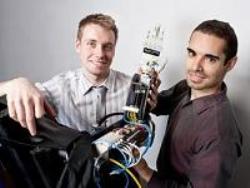Two undergraduate biomedical students from Ryerson University have built Artificial Muscle-Operated (AMO) arm, a robotic arm controlled by brain signals.
Unlike conventional prosthetic arms, which feature advanced electronic and mechanical parts, the robotic prosthetic arm includes simple pneumatic valves, pumps and a tank filled with compressed air to generate motion. This has enabled the prosthetic arm to be built at barely one-quarter of the total cost of a conventional prosthetic arm.
 Artificial Muscle-Operated Arm
Artificial Muscle-Operated Arm
In addition, neural signal-controlled prosthetic arms need a costly and highly-invasive re-innervation operation to re-direct significant nerves and also require several training sessions. Whereas the AMO arm utilizes brain signals that are measured using a device worn on the head. The device is linked to a computer that manipulates the pneumatic system of the robotic arm.
Michal Prywata, one of the inventors of the AMO arm, stated that users need just 10 minutes to learn the basic working of the prosthetic arm. He mentioned that the pneumatic aspect of the AMO enables a wider motion range in contrast to other prosthetic limbs.
The new technology enables several applications including military robotics and wheelchair systems. Investigation initiatives are in progress to include enhancements like automatic finger motions and assisting the arm to sense the type of material it is grasping.